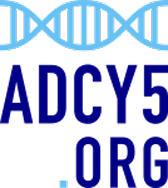Community
Ginevra’s Story
Hi! Can you start by sharing a little about yourself and your family?
My daughter Ginevra is only 8 years old, but mentally she is definitely more mature — I imagine this happens to children who immediately have to deal with diseases and hospitals, and maybe this is also a common denominator in these stories.
I could compare Ginevra to a warm spring day — fragrant, cheerful and puts you in a good mood! She loves animals like her mother, she loves the mountains like her father, and she is generous, sweet, kind and very tender with her brother. We live in Italy in a little town named Perugia.
Can you tell us about the first symptoms you noticed? When did you first realize there might be something different or unusual?
As parents we understood that something was wrong when she was about 10 months. The pregnancy, breastfeeding and weaning had been typical, but it was when she had to start walking that the first difficulties began and the first involuntary movements appeared. From that moment on, specialist visits, hospitalizations and various kinds of examinations followed one another for years, and we immediately started therapy with Artane. As Ginevra grew, the spasms increased and the difficulty in walking became more and more evident. Then came physiotherapy, the swimming pool, the braces, the wheelchair and many attempts with drugs of various kinds.
For us, those were distressed and lonely years in which we watched our daughter grow and get worse without any doctor being able to give us certainty on how to proceed, instead it was a succession of unsuccessful attempts. Over time, our desire for a second child also grew, and despite the fears, difficulties and uncertainty of our life, we had the courage to try and were rewarded with a little brother for Ginevra, Francesco, who brought joy, hope and somehow remodeled the family balance.
“Every year she acquires new skills, but her greatest strength is her steel character: she never gives up, with a determination that leaves us speechless and excites us and fills us with pride.”
What was your journey to getting a diagnosis? What specialists or testing did you go through, and how long did it take to get the result?
In November 2017 we got some wonderful news: finally a diagnosis! It was thanks to the Florence Hospital, who followed us from the early stages of the research, and in particular to Professor Guerrini, head of the Child Neuropsychiatry Department. The diagnosis arrived after 5 years, and showed the de novo mutation of the ADCY5 gene (c.1252C> T; pR418W)
Describe how you live with ADCY5‐related movement disorder (ADCY5‐RMD) day-to-day: how is your routine similar or different to others? What are some ‘wins’ and ‘lows’ right now?
Since 2017, Ginevra has flourished. Every year she acquires new skills, but her greatest strength is her steel character: she never gives up, with a determination that leaves us speechless and excites us and fills us with pride. When Ginevra puts her mind to something, she can do it, and this is her greatest talent!
What are you excited about when you think of the future? How has your outlook changed (before and since the diagnosis), and what gives you hope?
Our daughter lacks nothing, she is infinitely better than I ever dreamed. We want only for her to be always happy, as every parent would, as well as free and independent, but we know that for this last wish we need science and a lot of luck!
More Patient Stories
Maya
We welcomed our first child, Maya, into the world in February 2013. She was strong, happy, healthy and ‘typical’ in every way at birth. Our first gut feeling…
Laura
Laura was diagnosed with ADCY5‐related movement disorder (ADCY5‐RMD) several years ago, and she is now 14. We live in Florida, where Laura enjoys ballet, gymnastics, cheering for her…
Newly Diagnosed?
The most important thing our rare ADCY5‐related movement disorder (ADCY5‐RMD) community needs to do is come together to build knowledge and collect information.





